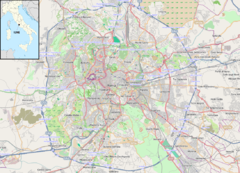Palazzo Braschi
| Palazzo Braschi | |
|---|---|

Façade of the palace on Piazza di S. Pantaleo
|
|
| General information | |
| Type | Palace |
| Architectural style | Neoclassical |
| Address | Piazza di S. Pantaleo 10 |
| Town or city | Rome |
| Country | Italy |
| Coordinates | 41°53′50″N 12°28′22″E / 41.8973°N 12.4729°ECoordinates: 41°53′50″N 12°28′22″E / 41.8973°N 12.4729°E |
| Current tenants | Museo di Roma |
| Construction started | 1790 |
| Client | Luigi Braschi Onesti |
| Design and construction | |
| Architect | Cosimo Morelli |
Palazzo Braschi is a large Neoclassical palace in Rome, Italy and is located between the Piazza Navona, the Campo de' Fiori, the Corso Vittorio Emanuele II and the Piazza di Pasquino. It presently houses the Museo di Roma, the "museum of Rome", covering the history of the city in the period from the Middle Ages through the nineteenth century.
It was built by the papal nephew Duke Luigi Braschi Onesti, to designs by Cosimo Morelli. The site was purchased in 1790 by Braschi, supported by funds from Pope Pius VI; Braschi demolished the 16th-century palace that Giuliano da Sangallo the Younger had built for Francesco Orsini in order to erect his own from the ground up. Construction was suspended in February 1798 during the Napoleonic occupation of the city, when the French temporarily took possession of it until 1802 and confiscated the recently acquired collection of antiquities it contained (though Braschi was reimbursed for them). In 1809, when Rome was declared an Imperial city by Napoleon, Duke Luigi moved into the palace and was declared mayor.
On his death in 1816 the palace remained unfinished and the family funds depleted. In 1871 the Braschi Onesti heirs sold the building to the Italian State, who made it the seat of the Ministry of Interior (now moved into Palazzo del Viminale). During the Italian fascist period, it was used as the political headquarters of Benito Mussolini, and was adorned with a giant sculpture of the dictator's face. After the war, it housed 300 refugee families and many of the interior frescoes were seriously damaged by the fires they lit to keep warm. In 1949 the palace passed to the civic authorities and, following extensive conservation in 1952, the present installation of the museum was effected.
...
Wikipedia

